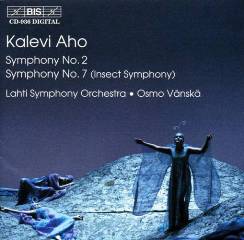Kalevi Aho - Symphonies No.2 & 7 (1998)
Kalevi Aho - Symphonies No.2 & 7 (1998)

1 Symphony No.2 (1970/1995) in one movement 21:14 Symphony No.7 (1988) 'Insect Symphony' / 'Hyönteissinfonia' 2 I Kulkuri, Loispistiäinen Ja Sen Toukka / The Tramp, The Parasitic Hymenopter And Its Larva 7:04 3 II Perhoset (Perhosten Foxtrot Ja Tango) / The Butterflies (The Foxtrot And Tango Of The Butterflies) 4:33 4 III Sittiäiset (Suru Varaustetusta Sontapallosta) / The Dung Beetles (Grief Over The Stolen Ball Of Dung) 3:52 5 IV Heinäsirkät / The Grasshoppers 6:11 6 V Muurahaiset (Muurahaisten Työmusiikki Ja Sotamarssit I Ja Ii) / The Ants (The Working Music Of The Ants And War Marches I And Ii) 11:13 7 VI Päivänkorennot (Päivänkorentojen tanssi ja kehtolaulu kuoleille päivänkorennoille) / The Dayflies and Lullaby for the Dead Dayflies Lahti Symphony Orchestra Osmo Vänskä – conductor
The Second Symphony is a youthful work – the composer was just 21 at the time – but it differs from the First in that it’s cast in a single movement. After the premiere in 1973 Aho decided to rework the middle section, a task he didn’t attempt until 1995. The result is a compact, tightly structured piece – it’s a triple fugue – which the composer candidly admits was intended as an antidote to some of the more ‘difficult’ music of the 1960s.
As with the fugues in the First Symphony there’s no hint of dutifully reconstructed baroquerie or dry didacticism; instead, Aho uses fugues to create a remarkably dramatic and cohesive symphonic whole.
And despite the echoes of Shostakovich in the First Symphony it would be wrong to think of Aho’s early musical style as ‘Shostakovich-lite’. Yes, DSCH could be the model for the brooding theme that ushers in the Second Symphony but there is enough in this unfolding music to suggest the composer is finding his own ‘voice’. Just listen to that extraordinary sustained passage that begins at 10:03, excerpt where we enter a more individual, more rarefied soundscape altogether.
There is a pleasing directness to Aho’s musical utterances that will appeal to those who find much late-20th-century music too dry or relentless. Even though this symphony may only last 20 minutes there is much to discover and enjoy here. As always Vänskä and his Lahti band – the mainstays of this cycle – are very well recorded, especially in the symphony’s final, more spectral, moments. excerpt
This well-filled disc also offers a splendid performance of Aho’s Seventh Symphony, penned after the composer took a break to concentrate on his concertos and other works. The intriguing subtitle, ‘Insect Symphony’, is derived from the composer’s opera Insect Life, which he entered for a Savonlinna Opera Festival competition in 1988. The work was rejected at the time, so rather than abandon it altogether Aho decided to recast it as a symphony. Incidentally, Savonlinna’s loss was Helsinki’s gain, as Insect Life was given a triumphant premiere by Finnish National Opera in 1996.
The result is a set of six pieces that contain conventional musical forms, including a foxtrot, tango, marches and lullaby. The first movement, ‘The Tramp, the Parasitic Hymenopter and its Larva’, takes its cue from the opera’s only human character, a drunk vagrant who anthropomorphises the insects he encounters. Investing them with human feelings and foibles is not as twee or Disneyfied as it may seem; indeed, Aho provides music of considerable wit and character here.
The tipsy brass and bass-drum pratfalls of the first movement are nicely done, excerpt and despite the episodic nature of this work Aho manages to weld the sections into a fairly convincing symphonic whole. There is music of real virtuosity throughout that calls for contributions from solo piccolo, flute, trumpet, tuba and cello. Naturally, the deliciously louche ‘Foxtrot and Tango of the Butterflies’ demands an alto sax, stylishly played by Hannu Lehtonen. It’s infectious stuff, the rhythms as sharp as a razor. excerpt The tango especially has a sultry charm that is most enjoyable, the players clearly relishing the chance to let their hair down a little.
The somewhat ungainly sounds of the next movement manage to suggest the squat shape of the hard-working dung beetles. I suppose one could argue that this is the kind of workaday accompaniment one might expect from an Attenborough documentary but really you’ll find nothing there that is as accomplished as this. You won’t hear crude musical imitation in ‘The Grasshoppers’ either; even though there is an appropriate chirpiness to the writing here.
The martial rhythms of the working ants are subtly done, with fine contributions from the Lahti brass and percussionists. It’s strong, muscular music that never breaks its stride, the sheer range of Aho’s colour palette very impressive indeed. And there’s a satirical edge to these marches that Shostakovich would surely have enjoyed. Just listen to the gong’s long, slow decay into silence at the end of this movement, a simple device but hair-raising nonetheless.
Aho is in a much more reflective mood when it comes to the short-lived dayflies. Is there a philosophical dimension to this movement? Perhaps; the music certainly has a fleeting, evanescent quality that is most apt. Aho’s melodic strengths are very much in evidence here, the music unfurling like the passing hours. It’s not all wistfulness – there are some splendid climaxes too – but the symphony does draw to a gentle, reflective close. Aho provides music of great tenderness and beauty here, an extended lament, moving in its simplicity. excerpt
Even though the composer can’t quite disguise the ‘bitty’ nature of this score – one could argue that it’s more of a suite than a symphony – it is bound together by music of great originality and charm. Kudos to all involved, especially the BIS engineers, who have produced another astounding disc. Not to be missed. ---Dan Morgan, musicweb-international.com
download (mp3 @320 kbs):








